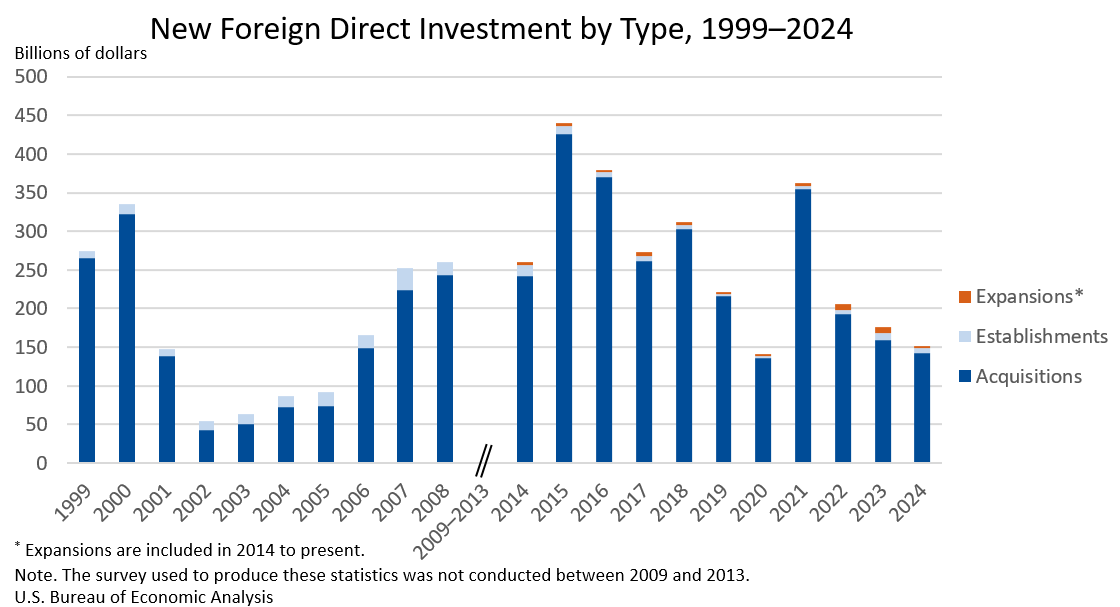Bureau of Economic Analysis
New Foreign Direct Investment in the United States, 2024
Expenditures by foreign direct investors to acquire, establish, or expand U.S. businesses totaled $151.0 billion in 2024, according to preliminary statistics released today by the U.S. Bureau of Economic Analysis. Expenditures decreased $24.9 billion, or 14.2 percent, from $176.0 billion (revised) in 2023 and were below the annual average of $277.2 billion for 2014–2023. As in previous years, acquisitions of existing U.S. businesses accounted for most of the expenditures.
Principal Federal Economic Indicators
Noteworthy
- 2025 News Release Schedule
- Innovation at BEA
- 2025 Annual Updates
- New! Services Trade Data for More Countries
- Data Tool: Trade in Value Added
- Distribution of State Personal Income
- Updated: RIMS II Regional Multipliers
- Arts and Culture
- Space Economy
- FDI Now in State BEARFACTS
- Quick Guide: Price Indexes
The Latest
Northern Mariana Islands' Economy Grew 4.4 Percent in 2013
Newly published estimates of gross domestic product for the Commonwealth of the Northern Mariana Islands (CNMI) show that real GDP – GDP adjusted to remove price changes – increased 4.4 percent in 2013.
Widespread Growth Across Industries in Second Quarter 2014
Real gross domestic product (GDP) increased at an annual rate of 4.6 percent in the second quarter of 2014, after decreasing 2.1 percent in the first quarter. Both private goods- and services-producing industries contributed to the increase, while the government sector decreased.
Gross Domestic Product by Industry, 2nd quarter 2014; Revised Statistics of Gross Domestic Product by Industry for 1997 through 1st quarter 2014
Real gross domestic product (GDP) increased at an annual rate of 4.6 percent in the second quarter of 2014, after decreasing 2.1 percent in the first quarter. Both private goods- and services-producing industries contributed to the increase, while the government sector decreased. Durable‐goods manufacturing; finance and insurance; and retail trade were the leading contributors.
September 2014 Trade Gap is $43.0 Billion
The U.S. monthly international trade deficit increased in September 2014 according to the U.S. Bureau of Economic Analysis and the U.S. Census Bureau. The deficit increased from $40.0 billion in August (revised) to $43.0 billion in September, mainly reflecting a decrease in exports. The previously published August deficit was $40.1 billion. The goods deficit increased $2.4 billion from August to $62.7 billion in September; the services…
Consumer Spending Falls in September
Personal Income rose 0.2 percent in September after rising 0.3 percent in August. Wages and salaries, the largest component of personal income, rose 0.2 percent in September after rising 0.5 percent in August.
Current-dollar disposable personal income (DPI), after-tax income, rose 0.1 percent in September after rising 0.3 percent in August.
Real DPI, income adjusted for taxes and inflation, remained flat in…
Personal Income and Outlays, September 2014
Personal income increased $22.7 billion, or 0.2 percent, and disposable personal income (DPI) increased $15.7 billion, or 0.1 percent, in September, according to the Bureau of Economic Analysis. Personal consumption expenditures (PCE) decreased $19.0 billion, or 0.2 percent. In August, personal income increased $50.7 billion, or 0.3 percent, DPI increased $37.5 billion, or 0.3 percent, and PCE increased $58.7 billion, or 0.5 percent, based on…
GDP Growth Moderates in Third Quarter
Real gross domestic product (GDP) increased 3.5 percent in the third quarter of 2014, according to the “advance” estimate released by the Bureau of Economic Analysis. In the second quarter, real GDP increased 4.6 percent.
Third-quarter highlights The deceleration in GDP growth was more than accounted for by inventory investment, which detracted from growth in the third quarter after adding to it in the second quarter.…
Gross Domestic Product, 3rd quarter 2014 (advance estimate)
Real gross domestic product -- the value of the production of goods and services in the United States, adjusted for price changes -- increased at an annual rate of 3.5 percent in the third quarter of 2014, according to the "advance" estimate released by the Bureau of Economic Analysis.
Commerce Data: Then & Now
In July, Secretary of Commerce Penny Pritzker announced that our department will be hiring our first ever Chief Data Officer (CDO), building on her commitment to Commerce’s role as “America’s Data Agency.” She also announced the formation of a data advisory council comprising private sector leaders who will help the CDO navigate new and dynamic data challenges. This is the latest chapter in Commerce’s long history of adapting to serve the…




